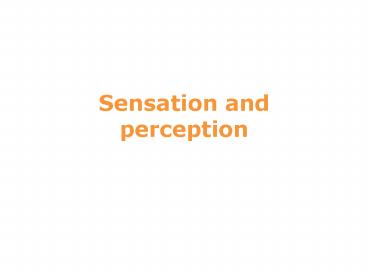Sensation and perception - PowerPoint PPT Presentation
1 / 20
Title: Sensation and perception
1
Sensation and perception
2
Definitions
- Sensation
- The detection of physical energy emitted or
reflected by physical objects. - Occurs when energy in the external environment or
the body stimulates receptors in the sense
organs. - Perception
- The process by which the brain organizes and
interprets sensory information.
3
Our Senses
- Vision
- Hearing
- Taste
- Smell
- Touch
4
Specific nerve energies
- Different sensory modalities exist because
signals received by the sense organs stimulate
different nerve pathways leading to different
areas of the brain. - Synesthesia
- A condition in which stimulation of one sense
also evokes another.
5
Absolute threshold
- The smallest quantity of physical energy that can
be reliably detected - Vision
- A single candle flame from 30 miles on a clear
night - Hearing
- The tick of a watch from 20 feet in total quiet
- Smell
- One drop of perfume in a 6-room apartment
- Touch
- The wing of a bee on the cheek, dropped from 1 cm
- Taste
- One teaspoon of sugar in 2 gallons of water
6
Difference threshold
- The smallest difference in stimulation that can
be reliably detected by an observer when two
stimuli are compared. - Also called the Just Noticeable Difference (JND).
7
Sensory adaptation and deprivation
- Adaptation
- The reduction or disappearance of sensory
responsiveness when stimulation is unchanging or
repetitious. - Prevents us from having to respond continuously
to unimportant information. - Deprivation
- The absence of normal levels of sensory
stimulation.
8
Sensory overload
- Over-stimulation of the senses.
- Can use selective attention to reduce sensory
overload. - Selective attention the focusing of attention on
selected aspects of the environment and the
blocking out of others.
9
What we see
- Hue
- Visual experience specified by color names and
related to the wavelength of light. - Brightness
- Visual experience related to the amount of light
emitted from or reflected by an object. - Saturation
- Visual experience related to the complexity of
light waves.
10
Trichromatic theory
- Young (1802) and von Helmholtz (1852) both
proposed that the eye detects 3 primary colors. - Red, blue, and green
- All other colors derived by combination.
11
Ambiguous Figure
- Also known as ambiguous illusions are pictures or
objects that elicit a perceptual 'switch' between
the alternative interpretations. - The brain can interpret the ambiguous cues in two
different ways.
12
(No Transcript)
13
Distorting Illusions
- Characterized by distortions of size, length, or
curvature.
14
Visual constancies
- The accurate perception of objects as stable or
unchanged despite changes in the sensory patterns
they produce
15
Color in context
- The way you perceive a color depends on the color
surrounds.
16
What we Hear
- Loudness
- The dimension of auditory experience related to
the intensity of a pressure wave. - Pitch
- The dimension of auditory experience related to
the frequency of a pressure wave. - Timbre
- The dimension of auditory experience related to
the complexity of a pressure wave.
17
What we Taste
- Five basic tastes
- Salty, sour, bitter, sweet, and umami
- Umami is one of the five basic tastes sensed by
specialized receptor cells present on the human - Umami is a Japanese word meaning savory, a
"deliciousness" factor deriving specifically from
detection of the natural amino acid, glutamic
acid, or glutamates common in meats, cheese,
broth, and other protein-heavy foods. - Glutamate appears in foods and food ingredients
such as - soy sauce
- fish sauce
- parmesan
- anchovies
- monosodium glutamate (MSG)
18
Different people have different tastes based on
- Genetics
- Culture
- Learning
- Food attractiveness
19
What we Smell
- Airborne chemical molecules enter the nose and
circulate through the nasal cavity. - Vapors can also enter through the mouth and pass
into nasal cavity. - Receptors on the roof of the nasal cavity detect
these molecules.
20
Somatosensory System
- Widespread and diverse sensory system
- touch
- temperature
- pain
- kinesthesia (body position and movement)
- equilibrioception (balance)































